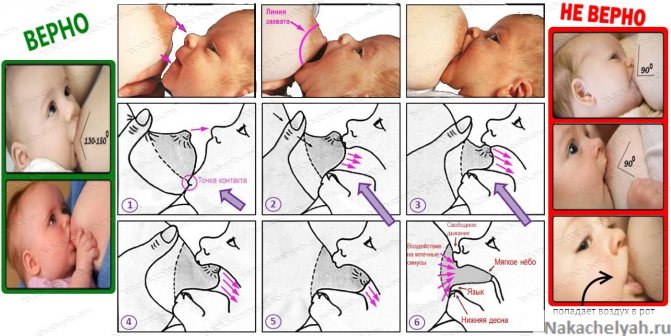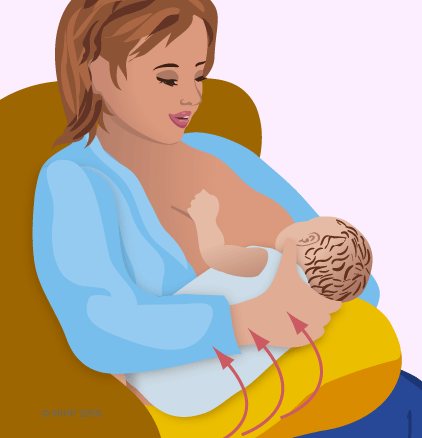How to teach a baby to latch on to the breast is a question asked by almost every woman who has a baby.
And even if the child is not the first, and you know the feeding technology very well, then there may still be certain subtleties, since children are all very different, and can behave differently during feeding. If you have your first child, then this issue is very acute. Let's take a closer look at how to teach a baby to latch onto the breast correctly, how to latch onto it, and how to prepare the breast for feeding the baby. Properly adjusted feeding in the first days and weeks of a baby’s life is the key to his harmonious development.
How to teach a baby to latch on to the breast - the first attachment
If the baby was born healthy and the birth took place naturally, then the first breastfeeding can be literally immediately after birth. This is already practiced in many maternity hospitals, although there is still an old practice when the baby is given for feeding only 6 - 12 hours after birth, and sometimes even after two days. This is not very good, since almost immediately after birth, the mother produces colostrum - the first milk. This is what gives the baby a very good start in life. In other words, colostrum has an ideal composition for a baby and brings him health.
In theory, if the baby is completely healthy, the unconditioned sucking reflex should work, so you don’t even have to worry too much about how to teach your baby to latch on.

.
However, children are different. In addition, if it so happens that the child was given to you after a couple of days, then all this time he was bottle-fed. In maternity hospitals, indicators are needed, therefore, if it is not possible to immediately feed the baby with breast milk, formula is actively used. This means that the baby is already accustomed to sucking on the pacifier and may be reluctant to switch to the breast. Therefore, if you want to breastfeed yourself, then you will have to master the question of how to teach your baby to suckle.
How to resume breastfeeding?
Despite the variety of factors that provoke a child’s refusal to suckle at the breast and get used to the bottle, the mechanism of decisions and actions is always the same.
To eliminate the main cause and additional factors, it will take quite a lot of time and mother’s patience. The ideal option is to throw all the mother’s energy into weaning the baby off the bottle and returning to breastfeeding.
That is why it is extremely necessary to get the support of household members, since all other everyday problems should fall on the shoulders of the spouse, adult first-born child or grandmothers. Of course, you need to warn about this in advance.

What exactly should a mother do? Listen to the advice of breastfeeding experts and implement them correctly. Experts offer the following useful recommendations.
- It is necessary to put aside everything that the child can suck, of course, with the exception of the mammary glands. Such a radical step solves two problems at once. First of all, it is natural for a baby to strive to suck the breast, so in the absence of a pacifier and bottle, he will take the breast, which is what the mother wants. In addition, the factor of nipple disorientation is removed. The baby will remember how to grasp the nipple correctly and will return to the mother’s breast.
- A woman needs to constantly maintain close physical contact. This advice from experts on breastfeeding also applies to breastfeeding. When a mother carries her baby in her arms and touches his body with her skin, this leads to some useful responses. In the mother's body, when the baby is applied to the mammary gland, the amount of oxytocin increases, as a result of which milk is released more strongly. The baby develops the warmest feelings for his mother, he feels her love, protection and tenderness. That is, breastfeeding is the most important condition for optimal psychological health of children.
- For a certain period of time, it is better to remove household members from caring for the child. It is better to ask them for help in household chores, and only the mother is responsible for feeding, putting them to bed, performing water procedures, rocking them to sleep and carrying them in her arms. However, if the baby begins to cry when changing a diaper or after bathing, it is better to entrust this task to the father or another loved one. The point of such manipulations is that the child should not have any negative associations with his mother. This will significantly contribute to natural feeding.
- Experts on breastfeeding strongly advise reducing the time spent in public places while weaning off the bottle. This method involves constantly staying at home, in a familiar environment, next to your beloved mother. At the very beginning of returning to natural feeding, experts recommend excluding visits to guests, the hospital, shortening the duration of festivities, and even abandoning them altogether.
- It is imperative to give breastfeeding when the baby needs it most. So, a newborn is simply “obliged”, due to natural reflexes, to fall asleep with his mother’s breast in his mouth. That is why, before falling asleep, children usually do not resist breastfeeding. Another convenient time period is immediately after the opening of children’s eyes, when the child has not yet “activated”. In addition, nighttime meals are also beneficial for breastfeeding. They increase milk secretion and help restore the correct sucking reflex.
- A nursing woman needs to do everything to ensure that the baby feels comfortable and as comfortable as possible when receiving milk. Mom should try to feed the baby in any position - sitting, standing and lying on a barrel. Another option is to use a special pillow. In addition, it is necessary to eliminate any distraction - the sounds of the TV, for example. If you have cracks in your breasts or problems with your nipples, you can first try feeding your baby using special pads on which you can drip a little milk.
- There is no need to insist if the child categorically refuses the breast and reacts extremely negatively to the offer to suckle milk. You cannot be irritated, much less force your baby to grab the nipple by force. To promote natural feeding, you should show maximum tenderness, patience and affection. In case of a whim, the mother should simply calm the baby down and try again after some time.
- If the child has become accustomed to the bottle, it is necessary to return to natural feeding as soon as possible. However, a new parent needs to behave correctly, that is, avoid the bottle as much as possible. In the absence of other options, the child will simply be forced to satisfy all his reflexes through the mother's mammary glands. In the future, this will help establish a normal food intake process.
- Breastfeeding experts also advise sleeping with your baby. Falling asleep together promotes close interaction almost every minute, and also provides the baby with unlimited access to breast milk at night - precisely at that time period when the milk secretion is best separated. At the same time, breastfeeding promotes optimal rest, since the woman does not have to jump up due to the baby's crying.
The sucking reflex is an innate ability of a newborn baby. It is so natural that breastfeeding is quite easy to establish.
However, this must be done correctly, having first established the reason for refusing breastfeeding and getting used to the bottle.
If the proposed steps did not help to retrain the baby, you should definitely contact your pediatrician. It is possible that the problems are associated with the anatomical features of the baby's oral cavity, intolerance to breast milk, or some other serious illness.
How to teach a baby to suck - a few simple recommendations and common mistakes
When starting to feed your baby, you should build on his natural unconditioned reflexes. We talked about them in the previous article. So, one of them is the sucking reflex. If the child does not understand what they want from him, then you can teach the child to suck as follows.

Touch the nipple to the baby's cheek. He will turn his head in this direction and open his mouth slightly. After this, you need to stick his nipple in there, and he will start sucking. This is an innate reflex, and if you did everything correctly, then there should be no problems. If you need to interrupt feeding, then simply stick your little finger into the corner of the baby’s mouth, then the baby will let go of the nipple and stop sucking on it. However, this is usually not required, because a fed baby often falls asleep and releases the breast on its own.
However, some mothers, trying to teach their baby to breastfeed, make a number of mistakes.
- Squeezing the cheeks to get the baby to open his mouth . This is a common mistake when the baby is reluctant to take the breast. The fact is that in this case, the child does not know where to turn his head, and only gets angrier. If he is also hungry, then the crying only intensifies.
- Artificial rotation of the baby's head in the desired direction . For many mothers, when something doesn’t work out, they become impatient. And they want to speed up the process by independently turning the baby’s head in the right direction. Most babies don't like this and begin to protest. Therefore, first of all, calm down yourself, and then talk kindly to your baby. Try again, entice him with your nipple. The baby will quickly understand what needs to be done.
There is a video in which a specialist tells with a specific example how to properly attach a baby to the breast.
How to prepare your breasts for feeding your baby
Before feeding your baby, you should take care of some hygiene. These actions must be fully observed at least in the first week of the child’s life. Then you can simplify the process a little.
Brief recommendations on how to prepare your breasts for feeding your baby:
- Wash your hands with soap. Banal advice, but many people forget about it.
- Wash your breasts with boiled water and gently dry with an ironed towel. This must be observed in the first week, then you can do it as desired. Many pediatricians, on the contrary, say that the breast has its own microflora, which is beneficial to the baby.
- Express a few drops of milk before feeding. This is also done at first to avoid unnecessary microbes that may enter the ducts of the mammary glands.
- After feeding, let your nipples air dry.
By preparing your breasts for feeding your baby in this way, you can be sure that your baby will not pick up any unnecessary infections.
How to teach your baby to latch on correctly
Why specifically teach a child to latch on to the breast? It would seem, what’s so special about such a simple process? In fact, babies and mothers are different, and some will immediately take the breast correctly, while others will have to be helped.
A very common mistake young mothers make is that the baby does not latch onto the breast correctly. This can lead to the fact that the baby will not be able to suck normally - he does not get enough to eat, or to the appearance of painful cracks on the chest - breastfeeding will become unpleasant for the woman. As a result, giving up breastfeeding altogether, as the nipple can become inflamed. To prevent this from happening, the baby must be taught to latch onto the breast correctly.

It is necessary for the child to take into his mouth not only the nipple, but also the area around the nipple - the areola. If the baby has latched onto the breast correctly, the areola is completely in his mouth, the lower lip is turned outward, and the nose, cheeks and chin fit tightly to the breast. The baby presses the gums on the areola and squeezes milk through the hole in the nipple. This position creates a tightness in the oral cavity, which means that the baby will not swallow excess air. The less excess air, the better digestion and less belching.
It is very dangerous when the baby only takes the nipple directly into his mouth. Although he will get milk in this way, he will certainly chew the nipple and may damage it. Also, in order not to damage the nipple, you should not feed the baby for a very long time during the first feedings. Especially if there is not enough milk yet.
There is a video in which a mother clearly explains how to properly attach a baby to the breast using a model. She also talks about a few other necessary points.
Feeding breasts comfortably
How we present the breast to the baby largely determines whether he will grasp the nipple circle deeply or close his jaws on the nipple itself (ouch!).
The basic rule is to position the baby close to you and so that the nipple points towards his nose at the start. For some mothers, it is absolutely not necessary to somehow shape and shape the breasts - everything works out that way. But there are situations when the baby needs a little help with latching. It is necessary to shape the chest so that he can grab it deeper.
To help the child, we need to squeeze the chest a little, and squeeze it in a certain plane. Imagine being treated to a big, thick, fluffy pie. And you are very hungry and want to bite off a bigger piece at once. To do this, you squeeze the pie so that more can fit into your mouth. Your fingers squeezing the cake will be parallel to your lips. They squeezed, lifted the pie to their nose, opened their mouth wide and - ah!...
It's the same with breasts. We need to squeeze it in the plane of the child’s mouth - then he will grab more. Below I will try to explain in detail using the example of breast support, when the baby is placed in a sitting position, supporting him with the hand opposite the breast (sometimes this position is called a cross cradle).

The “cross cradle” position is convenient when mother and baby are just learning to feed. Mom can easily control both the breast and the baby's head. Learn more about breastfeeding positions
Our mother is going to put the baby on her left breast. She will serve it with her left hand. Let's carefully look further at what she should do with her breasts, and what she shouldn't do ;).
The compressed chest resembles an oval. The child’s open mouth too. We need to make sure that the oval of the chest is elongated in the same direction as the baby’s mouth. Our thumb is parallel to the upper lip. It is located closer to the nipple than the fingers that support the breast from below.
We superimpose the silhouette of a child (pink) with an open mouth on our picture. It can be seen that the baby on the left will be able to effectively capture the isola. And the baby on the right will not only grab much less, he will also slide towards the nipple.
Important: Place your fingers far enough from the areola . As the wonderful consultant Diana Wassinger notes, “further than we wanted.” Even further. This is especially important for the index finger and the fingers that follow it. They are often placed too close to the areola. The result is that we ourselves limit the child’s grasp area. He would have opened his mouth even wider, but rested his chin on his mother’s fingers. So you need to step back five centimeters, or even more, from the nipple. If your breasts are small, this may mean that your index finger will end up on your ribcage. The pressure of the thumb, which is located much closer to the areola, causes the nipple to rise upward towards the baby's nose.
The rule of shaping the breast so that the baby can grasp it as deeply as possible works for any position. The fingers are always parallel to the baby's lips.
It is better not to use a “scissors” breast grab (between the index and middle fingers) - the fingers often slip towards the nipple, and the attachment becomes shallow. Plus, there is a risk of severe compression of the ducts, and, accordingly, the appearance of milk stagnation.
Breast support sorted out. Now - the actual breastfeeding
literature
Eastman A The Mother-Baby Dance: Positioning and Latch-On Morbacher N, Stock J. Breastfeeding Answer Book Newman J The Ultimate Breastfeeding Book of Answers Wiessinger D. Thoughts on positioning, Latch-on pictures with description, A latch-on checklist
Tweet Pin It
How to teach a baby to latch correctly - feeding positions
Each woman decides for herself how it is more convenient for her to feed her baby. Basically, mothers feed either in a sitting or lying position.
- Feeding while lying down. Many people prefer to do this lying down. The mother lies on her side and the baby lies next to her. In this case, you need to lean towards the baby until the nipple touches his mouth, then he will immediately start eating. For greater comfort, you can place a pillow under your elbow - this should be decided on the spot, to find the best option for yourself. Sometimes, in order for the baby to learn to latch correctly, you can place him on your stomach. Perhaps this position will seem more comfortable to you.
- Feeding while sitting. It is most comfortable to feed while sitting in a low chair, with your hands on the armrest. This way you will support the child. And in order not to get tired, you need to find the most comfortable position and relax.
There are a lot of different videos in which women show different positions on how to properly attach and breastfeed a baby. This is one of them
When it comes to teaching a baby to latch on correctly, any options are good. Experiment and find the most comfortable position for yourself. We searched the Internet and this is what we found:
- it is best to sit on a sofa or chair, and put some kind of support under your feet: a pillow or a small bench. This will make it easier to hold the baby.
"Cradle"- “Cross cradle” is a position for the very first feedings. There are two parallel issues here: one hand holds the baby, and the other helps control the correct grip.
- “From under the arm” - this pose can be used if the mother has stagnant milk. In this position, the baby sucks milk from the lateral and lower milk lobules.
- “Hanging” - this pose is for “lazy” kids. It helps the baby with sucking, as well as at the very beginning, when the breast has not yet been expressed.
- “Lying on your hand” - this method is convenient for feeding your baby at night. In this position, the mother reliably supports the baby. The only thing is that it is better to place a pillow under your back for comfort.
- Jack is a great pose if you experience congestion in the upper chest. In this position, the chin touches the sore spot, almost massaging it. The main thing is to place the baby so that his chin touches the place where stagnation is observed. And you need to carefully ensure that he lies on his side.
- a good position if you decide to feed the baby from one breast or the other.
"Lying on a pillow"- “Baby on top” is the optimal “travel” position. It is also good to use if milk flows in a large stream. In this position, the flow of milk will decrease.
- “On the hip” is one of the posture options if feeding in others has become boring.
- “In a sitting position” is a pose for older children. Again, it is convenient to use it in hiking conditions.
- "Sitting in a sling" . If the baby is in a sling, you can feed him without taking him out. You just need to loosen the sling a little.
- “Feeding + rocking” - this position is suitable if the baby needs to not only be fed, but also put to sleep.
In the next video, the mother shows different feeding positions and, in addition, talks a little about common mistakes.
How to teach a baby to latch correctly - feeding frequency
A newborn baby undergoes a huge adaptation to extrauterine life. Therefore, in the first days of his life, it is worth proceeding solely from his needs. And you need to feed him as often as he asks. If the baby was born a little premature, and you are teaching him how to latch on correctly, but he does not eat much at one meal, then you need to put him to the breast more often.
Frequent feeding increases lactation if milk does not come immediately. However, it is worth gradually developing a certain regime. When the baby gets stronger and begins to drink enough milk at one meal, the intervals between feedings can be increased. And by the age of one month, come to some kind of regime. Ideally, eat once every three hours. This regime is especially needed for twins. We have written a lot about this before.
The question of how to teach a child to latch correctly may become relevant if the baby has sucked a little and is sleeping. This also happens in weakened and premature babies. Here you can really use a trick: feed the baby naked.
Physiologically, breastfeeding for a child is quite a labor-intensive task, since he has to actively suck and, one way or another, strain. At the same time, if the baby is feeding in a cool room practically naked (or in a thin vest), then in order to warm up, he has to actively move. In this case, suck.
If super-comfortable conditions are immediately created for a newborn baby, then even an active baby will relax and fall asleep sweetly at his mother’s breast, even if he is not completely full.
Of course, the recommendation to feed naked is just a suggestion. However, this is exactly how we woke up our lazy baby, who in the first weeks did nothing but sleep and did not at all want to eat normally.
How to teach a baby to suckle - duration of feeding
The duration of feeding is a very individual matter. And it can vary from five minutes to half an hour. If you manage to teach your baby to breastfeed correctly and the baby actively eats, he will get full faster.
A weak or inactive child will become satiated more slowly. It is necessary to take into account that an inactive baby can suck, sleep, and suck again. You can understand that he did not eat enough and fell asleep. To do this, you just need to take the nipple out of his mouth, and he will immediately wake up and ask to eat again.
Gradually, any child will get stronger, he will suck more confidently and the duration of feeding will be reduced.
How to teach your baby to latch on - night feedings

For the first six months of his life, the baby will definitely eat at night. This is useful for both him and mom. Here again, the issue is resolved in two ways: a healthy, active child will certainly wake up and ask to eat. You just need to feed him and continue to sleep. Here you need to understand that even at night the child learns to latch and latch onto the breast on a subconscious level. Then he will do this automatically.
A weakened, premature baby can sleep for a long time. Therefore, you need to somehow control this process, and after 3-4 hours, wake him up and put him to your chest. The baby must eat, as he needs to eat often in order to get stronger faster.
Correct application

To establish breastfeeding, the baby needs to be properly latched. But how to achieve it?
A child is born with a sucking reflex, but he does not have the knowledge and skills of how to properly grasp his mother’s breast. This process must be learned.
So, how to visually determine whether the baby is attached to the breast correctly:
- The baby opens his mouth wide;
- The baby takes the breast as deep as possible;
- The newborn’s chin touches the chest tightly, as if leaning on it;
- The baby's lips are relaxed;
- When sucking, the cheeks remain round;
- There are no extraneous sounds during feeding.
Also important parameters for proper application are:
- Lack of pain and discomfort at the time of attachment and during feeding;
- Feeding is effective: you can hear or see the baby's throat;
- After feedings, the breasts are comfortably soft;
- The child is growing well and gaining weight.
If you see that your baby is having trouble latching on correctly, try these tips for effective latching:
- Take a position in which you will be comfortable feeding your baby for a long time. You can do this while sitting, lying down, using pillows or support for your feet;
- Do not reach or lean towards the child;
- It is better to apply to the breast when the baby is calm, ideally just waking up.
If the baby is crying, it is better to first calm him down and then offer the breast;
- Place your child as close to you as possible. Let your baby's belly be pressed against your belly and your shoulder, back and hip in a straight line;
- At the beginning of feeding, your nipple is at the same level as your baby's nose. Touch it to the area above the upper lip, and the baby will instinctively throw back his head and open his mouth wide;
- To help your baby, you can support your breast with your hand while you latch on. Place your thumb about 5 cm above the nipple, leave the rest of your fingers below and squeeze the breast slightly. Make sure that when latching onto the breast, the baby does not bump his lips into your fingers;
- If the baby does not latch deeply, carefully remove it so as not to damage the nipple and reattach it.
Don't worry if you don't succeed. It may take several tries or days to teach your baby to latch on correctly. And sometimes - the help of a consultant who will help in your specific situation to make friends with your baby at the breast.
Daria Leonovich, pediatrician, lactation consultant.
How to teach a child to latch and suck correctly - summary
We figured out how to teach a baby to breastfeed correctly. Overall, there is nothing supernatural here. You just need to not be afraid of experiments, find a position that is comfortable for yourself and the baby, stir up the sleepiness, and gradually build a feeding regimen.
Mothers need to remember that there is nothing healthier for a baby than breast milk. Therefore, it is in your power to teach him how to suck properly and establish breastfeeding.
For those who have twins, it makes sense to read how to feed twins.











